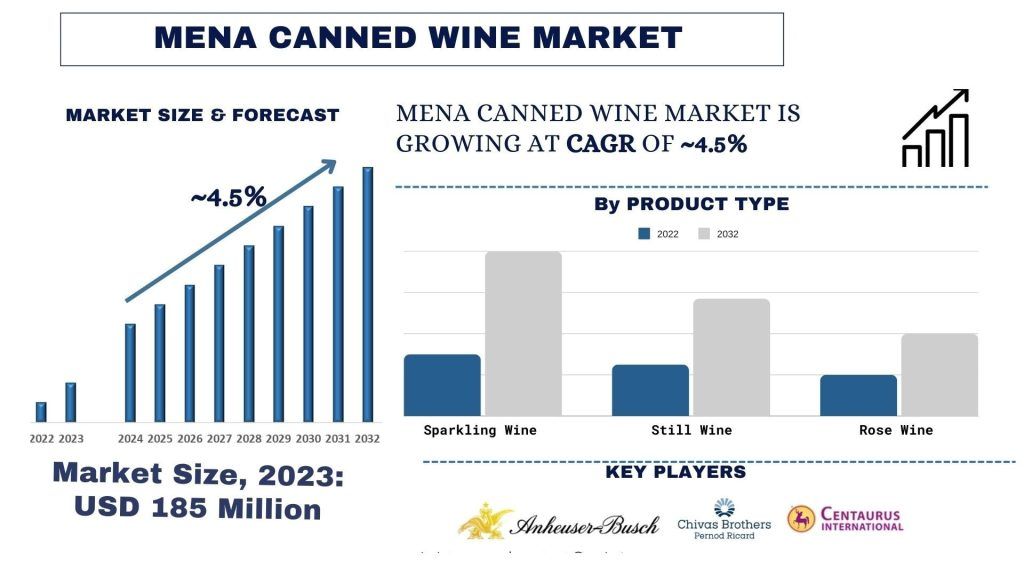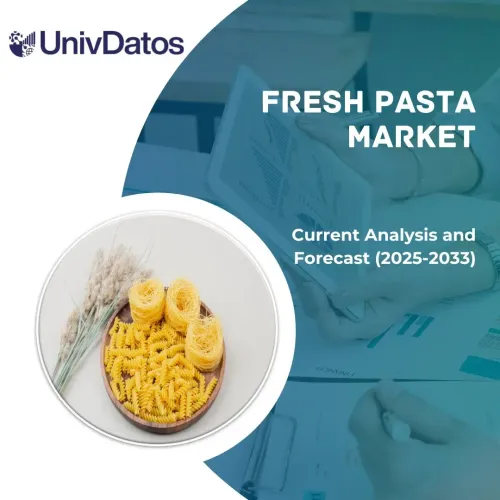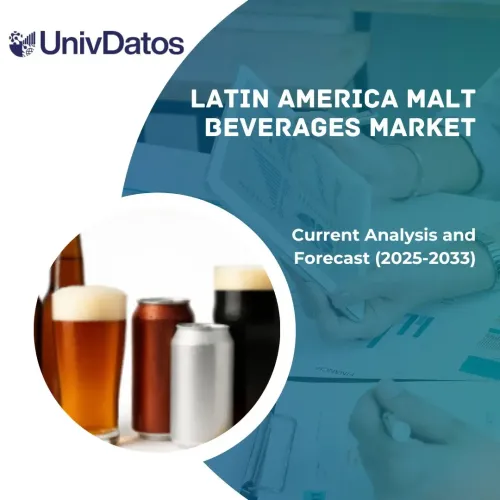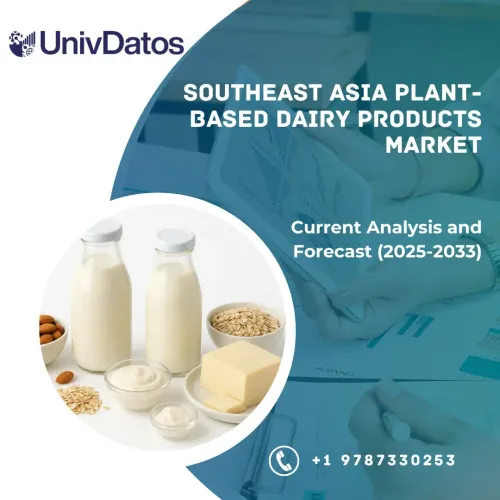- Home
- About Us
- Industry
- Services
- Reading
- Contact Us
MENA Canned Wine Market: Current Analysis and Forecast (2024-2032)
Emphasis on Product Type (Sparkling Wine, Still Wine, and Rose Wine); Distribution channel (Store Based and Non-Store Based); and Country
The MENA canned wine market was valued at approximately ~USD 185 million in 2023 and is expected to grow at a strong CAGR of around 4.5% during the forecast period (2024-2032) owing to the growing tourism industry.
MENA Canned Wine Market Analysis
The MENA canned wine market is expected to grow as consumers seek more convenient, reusable, and innovative solutions. The urbanization and lifestyle changes trends significantly influence the growth of the MENA canned wine market, particularly through the rising disposable income levels in the region, especially among the youth, driving spending on premium products. These trends reshape consumer preferences and drive manufacturers to innovate and adapt their product offerings. Company collaborations and innovative product launches also drive the industry’s growth.
For instance, In January 2022, Le Clos unveiled a limited edition 50-year-old celebration edition blended whisky. This exclusive edition is a rare, meticulously crafted blend sourced from some of Scotland’s most renowned distilleries. The collection is limited to 120 bottles and is exclusively offered at Le Clos outlets in Dubai International Airport (DXB) and through its online platform at leclos.net.
MENA Canned Wine Market Trends
This section discusses the key market trends that are influencing the various segments of the MENA canned wine market, as identified by our team of research experts.
Still Wine Segment Transforming Industry
The still wine segment led the market due to its established popularity and expansion into a more convenient and accessible format. Consumers in the MENA region, known for their preference for traditional still wines, are increasingly seeking on-the-go options that fit their active lifestyles. Canned wines offer the same high-quality taste and variety as bottled still wines but in a portable, single-serving format, appealing to younger, urban demographics and outdoor enthusiasts. Additionally, the sustainability benefits of canned packaging, such as lower carbon footprints and easier recycling, resonate with the growing environmentally conscious consumer base in the region. This shift towards convenience and sustainability is propelling the growth of the still wine segment within the broader MENA canned wine market.
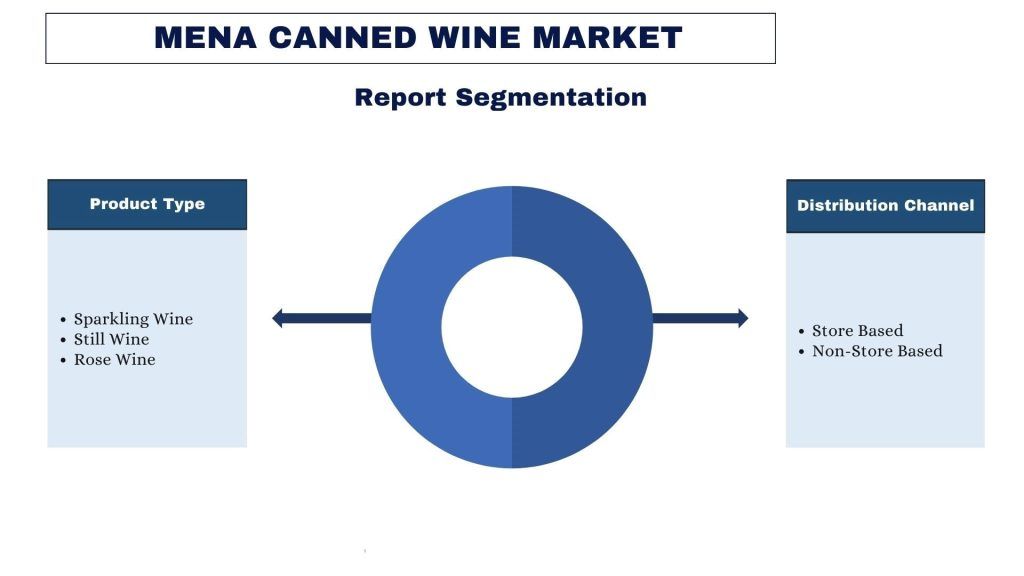 UAE is Expected to Grow at a Significant CAGR During Forecast Period
UAE is Expected to Grow at a Significant CAGR During Forecast Period
The UAE canned wine market involves the production, distribution, and consumption of wine packaged in cans, offering a modern and convenient alternative to traditional wine bottles. The market is witnessing growth due to several factors, including increasing urbanization, a rising expatriate population, and the growing trend of on-the-go and outdoor socializing, which favors portable beverage options. Additionally, the market benefits from the UAE’s booming tourism and hospitality sectors, where easy-to-serve and innovative packaging solutions are highly valued. As consumers in the UAE become more open to new and diverse drinking experiences, the demand for canned wine continues to rise, further driven by effective marketing strategies and the appeal of sustainable packaging.
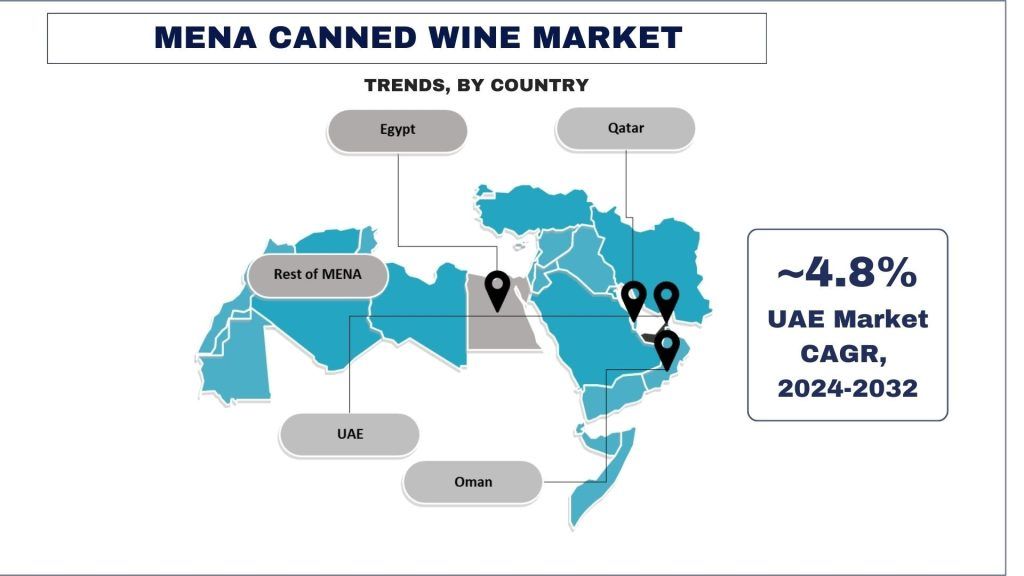
Canned Wine Industry Overview
The MENA canned wine market is competitive, with several global market players. The key players are adopting different growth strategies to enhance their market presence, such as partnerships, agreements, collaborations, new type launches, geographical expansions, and mergers and acquisitions. Some of the major players operating in the market are Château Ksara, Anheuser-Busch Companies LLC, Bacardi & Company Limited, Brown‑Forman, Chivas Brothers Limited, Al Hamra Cellar, MMI Dubai, African Eastern, Centaurus International, Devine
MENA Canned Wine Market Report Coverage
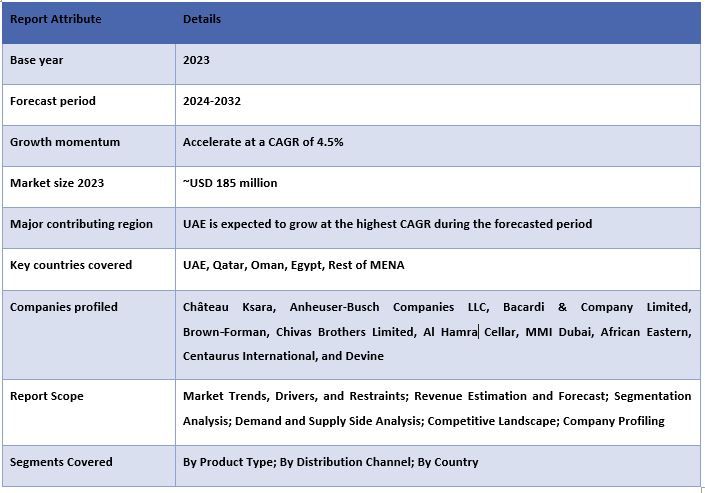
Reasons to buy this report:
- The study includes market sizing and forecasting analysis validated by authenticated key industry experts.
- The report presents a quick review of overall industry performance at one glance.
- The report covers an in-depth analysis of prominent industry peers with a primary focus on key business financials, type portfolios, expansion strategies, and recent developments.
- Detailed examination of drivers, restraints, key trends, and opportunities prevailing in the industry.
- The study comprehensively covers the market across different segments.
- Deep dive regional level analysis of the industry.
Customization Options:
The MENA canned wine market can further be customized as per the requirement or any other market segment. Besides this, UMI understands that you may have your own business needs, hence feel free to connect with us to get a report that completely suits your requirements.
Table of Content
Research Methodology for the MENA Canned Wine Market Analysis (2024-2032)
Analyzing the historical market, estimating the current market, and forecasting the future market of the MENA canned wine market were the three major steps undertaken to create and analyze the adoption of canned wine in major regions. Exhaustive secondary research was conducted to collect the historical market numbers and estimate the current market size. Secondly, to validate these insights, numerous findings and assumptions were taken into consideration. Moreover, exhaustive primary interviews were also conducted, with industry experts across the value chain of the MENA canned wine market. Post assumption and validation of market numbers through primary interviews, we employed a top-down/bottom-up approach to forecasting the complete market size. Thereafter, market breakdown and data triangulation methods were adopted to estimate and analyze the market size of segments and sub-segments of the industry pertains to. Detailed methodology is explained below:
Analysis of Historical Market Size
Step 1: In-Depth Study of Secondary Sources:
A detailed secondary study was conducted to obtain the historical market size of the MENA canned wine market through company internal sources such as annual reports & financial statements, performance presentations, press releases, etc., and external sources including journals, news & articles, government publications, competitor publications, sector reports, third-party database, and other credible publications.
Step 2: Market Segmentation:
After obtaining the historical market size of the MENA canned wine market, we conducted a detailed secondary analysis to gather historical market insights and share for different segments & sub-segments for major regions. Major segments are included in the report as product type, distribution channel, and regions. Further country-level analyses were conducted to evaluate the overall adoption of testing models in that region.
Step 3: Factor Analysis:
After acquiring the historical market size of different segments and sub-segments, we conducted a detailed factor analysis to estimate the current market size of the MENA canned wine market. Further, we conducted factor analysis using dependent and independent variables such as product type, distribution channel, and regions of the MENA canned wine market. A thorough analysis was conducted of demand and supply-side scenarios considering top partnerships, mergers and acquisitions, business expansion, and type launches in the MENA Canned Wine Market sector across the globe.
Current Market Size Estimate & Forecast
Current Market Sizing: Based on actionable insights from the above 3 steps, we arrived at the current market size, key players in the MENA canned wine market, and market shares of the segments. All the required percentage shares split, and market breakdowns were determined using the above-mentioned secondary approach and were verified through primary interviews.
Estimation & Forecasting: For market estimation and forecast, weights were assigned to different factors including drivers & trends, restraints, and opportunities available for the stakeholders. After analyzing these factors, relevant forecasting techniques i.e., the top-down/bottom-up approach were applied to arrive at the market forecast for 2032 for different segments and sub-segments across the major markets globally. The research methodology adopted to estimate the market size encompasses:
- The industry’s market size, in terms of revenue (USD) and the adoption rate of the MENA canned wine market across the major markets domestically
- All percentage shares, splits, and breakdowns of market segments and sub-segments
- Key players in the MENA canned wine market in terms of types offered. Also, the growth strategies adopted by these players to compete in the fast-growing market
Market Size and Share Validation
Primary Research: In-depth interviews were conducted with the Key Opinion Leaders (KOLs) including Top Level Executives (CXO/VPs, Sales Head, Marketing Head, Operational Head, Regional Head, Country Head, etc.) across major regions. Primary research findings were then summarized, and statistical analysis was performed to prove the stated hypothesis. Inputs from primary research were consolidated with secondary findings, hence turning information into actionable insights.
Split of Primary Participants in Different Regions

Market Engineering
The data triangulation technique was employed to complete the overall market estimation and to arrive at precise statistical numbers for each segment and sub-segment of the MENA canned wine market. Data was split into several segments and sub-segments after studying various parameters and trends in the product type, distribution channel, and regions in the MENA canned wine market.
The main objective of the MENA Canned Wine Market Study
The current & future market trends of the MENA canned wine market were pinpointed in the study. Investors can gain strategic insights to base their discretion for investments on the qualitative and quantitative analysis performed in the study. Current and future market trends determined the market’s overall attractiveness at a regional level, providing a platform for the industrial participant to exploit the untapped market to benefit from a first-mover advantage. Other quantitative goals of the studies include:
- Analyze the MENA canned wine market’s current and forecast market size in terms of value (USD). Also, analyze the current and forecast market size of different segments and sub-segments.
- Segments in the study include areas of the product type, distribution channel, and regions.
- Define and analyze the regulatory framework for the canned wine
- Analyze the value chain involved with the presence of various intermediaries, along with analyzing customer and competitor behaviors of the industry.
- Analyze the MENA canned wine market’s current and forecast market size for the major region.
- Major countries of regions studied in the report include UAE, Qatar, Oman, Egypt, and the Rest of the MENA.
- Company profiles of the MENA canned wine market and the growth strategies adopted by the market players to sustain in the fast-growing market.
- Deep dive regional level analysis of the industry
Frequently Asked Questions FAQs
Q1: What is the MENA Canned Wine Market's current market size and growth potential?
Q2: What are the driving factors for the growth of the MENA Canned Wine Market?
Q3: Which segment has the largest share of the MENA Canned Wine Market by Product Type category?
Q4: What are the emerging technologies and trends in the MENA Canned Wine Market?
Q5: Which region will dominate the MENA canned wine market?
Related Reports
Customers who bought this item also bought

